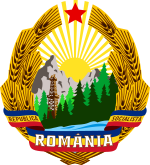
Back Румыния Социалистик Республикаһында киҫкен иҡтисад сәйәсәте (1980 йылдар) Bashkir Политика на строги икономии (СРР) Bulgarian Política de austeridad rumana de los años 1980 Spanish משטר הצנע הרומני שקדם למהפכה HE Կոշտ տնտեսման քաղաքականություն Ռումինիայում (1980-ական թվականներ) Armenian Политика жёсткой экономии СРР (1980-е) Russian มาตรการรัดเข็มขัดในประเทศโรมาเนีย คริสต์ทศวรรษ 1980 Thai Політика жорсткої економії в Румунії 1980-х Ukrainian
| ||
|---|---|---|
|
Personal Governmental positions Government and politics Political ideology Opposition  |
||
| Part of a series on the |
| Socialist Republic of Romania |
|---|
 |
In the 1980s, severe austerity measures were imposed in the Socialist Republic of Romania by President Nicolae Ceaușescu in order to pay out the external debt incurred by the state in the 1970s. Beginning in 1981, the austerity led to economic stagnation that continued all throughout the 1980s, a "sui generis shock therapy" which lowered the competitiveness of the Romanian economy and decreased the amount of exports.[1]
Although the measure helped pay off the debt, the harsh austerity measures negatively affected the living standards of the Romanians, increased shortages[1] and eventually led to the execution of Nicolae Ceaușescu and collapse of the Romanian Communist Party through the Romanian Revolution in December 1989.
